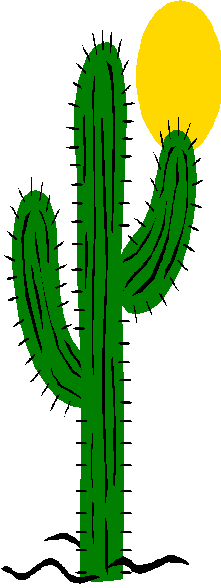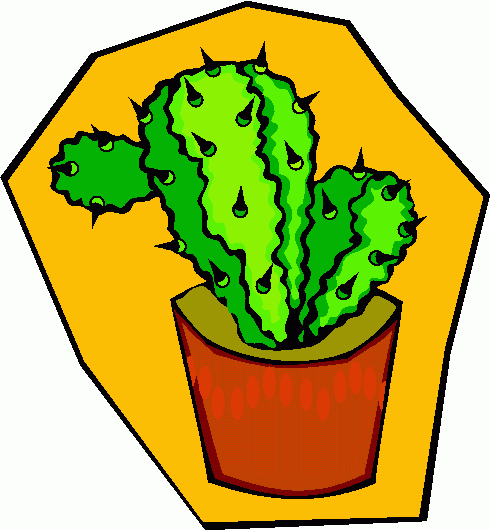|
Jump to:
Soil
General Culture
Soil for Cacti and Succulents
Soils for cacti and succulents are normally well drained. There are probably as many variations in cactus and succulent soil mixes as there are growers. The types of soil mix a grower uses reflects the growing habits of the grower. Those that grow under greenhouse conditions, in plastic pots or water frequently may find well drained mixes help prevent root rot or other problems relating to drainage. Mixes with better water holding characteristics would be better for growers growing in clay pots, or under conditions where their plants may get watered less frequently or less thoroughly.
Most succulent growers will build their soil mix to meet their own needs by combining ready-made mixes or peat moss with other materials to increase drainage. What they are changing is the porosity of the soil--the amount of open spaces in soil that can be filled with water or air. Larger pores will be predominantly filled with air and smaller pores with water. When soil is irrigated all of the pores are filled with water and the soil is said to be saturated. As gravity pulls water down through the soil air is pulled into the soil. Conditions that prevent or slow this drainage--such as heavy soil, very little pore space or water in trays under the pots--will create poor growing conditions for cacti and succulents or encourage the development of root and stem diseases.
Some soil content is up to both the creativity of the grower and availability of materials (in the 1950s it was not uncommon to find peanut hulls and garden soil in geranium mixes because they were free and locally available). If you have a difficult time growing a particular type of plant in one soil, then modify the mix or switch to another.
Common Components of Potting Mixes
Coconut Coir
Also called coir, this is the shredded inner fibers from the coconut. It is easy to re wet so it makes a good addition to peat mixes (which tend to be difficult to wet once dried). Use a trusted source; some coir can contain significant levels of salt.
Peat Moss
Peat moss is the preserved and only partially decomposed remains of sheets of sphagnum moss plants that have been lying under the surface of bogs. Peat moss has good water holding and nutrient holding capacity. Mixes with a lot of peat moss may hold too much water for cacti and succulents. Soil mixes may also contain reed-sedge peat which are the mostly decomposed remains of various bog plants. Reed sedge peat gives potting mixes a fine black texture and will stain hands and clothing. Reed sedge peat mixes do not drain well.
Sand
Sand is the most common drainage material recognized by growers. Coarse sand is best. Fine sand, such as play sand or builders sand, does not aid drainage as much as coarse silica sand. Sand is heavy and helps provide weight needed to counterbalance tall plants in small pots. One club member cautions that some sand is cleaned by rinsing with diesel fuel so be cautious when selecting a supplier. Sand does not hold on to nutrients well.
Perlite
Perlite is a coarse and light soil component that is made by heating silica rock to high temperatures. It can be very dusty and an irritant to eyes and sinuses. Use horticultural grade perlite which is more coarse. Perlite will retain more water than sand.
Turface
Another coarse drainage material is turface. This is a fired clay product that has some nutrient holding capacity and increases the drainage in the mix. It is a more uniform product than sand and will hold onto more nutrients. It is lighter than sand but heavier than pumice.
Other potting materials you will run into might include composted bark, leaf humus, rice hulls or bio solids. Vermiculite is another component; it holds a great deal of water and might not be appropriate for succulents. One thing you should not add to a potting mix is garden soil. Soil from the yard or garden is not well suited for root growth in a pot and may also introduce pests and diseases into the potting mix.
Toppings
Thin layers of stone or gravel on top of the soil serve several functions. This stone mulch will preserve moisture in the pot and help prevent weeds. Also, you can select types of gravel for ornamental effect. Various sizes of crushed granite are available as chicken grit. River gravel is available in several sizes from landscape supply yards. More colorful options can be found at aquarium (pet) stores. Larger, heavier gravel will help hold new transplants upright.
Mix Your Own Potting Soil
Growers may purchase a ready made potting mix either for general use or for cacti. Changing the mix to suit your own needs or growing habits can be a simple as adding a small amount of one of the previously mentioned components.
An easy way to mix soil is to use percentages. This will let you create a recipe that you can change or reproduce as needed. To use percentages find a container to use as a measure--the size doesn’t matter. If each full container represents 10% then ten containers would equal 100%. Using this measuring technique, 5 parts of peat moss and 5 parts of perlite would be a 50% peat 50% perlite mix. A half-part would be 5%.
Moisten ingredients before mixing to hold down dust. As long as it is not too wet, mixed soil can be stored for a long time. If plants do not grow well in a particular mix, consider changing it before transplanting. It is not uncommon to have several soil mixes for different types of cacti, succulents, or other plants in your collection.
Download a PDF of this article with photos and additional information
General Plant Care
Growing cacti and succulent plants can be easy and fun if you understand a little plant anatomy, its natural growing conditions and a few basic guidelines.
First, all cacti and succulents are succulents. “Succulent” is a term for plants that have special physical features that allow them to survive long periods of drought, such as thick fleshy stems or leaves or roots that store water. Their skin may be grooved to allow shriveling without cracking or to catch dew, fog or scarce seasonal rainwater. Knobby skin reduces a plant’s drying surface and moisture loss. Spines add shade, catch due and protect from pests. Thick roots store water, whereas thin shallow roots spread out to seek fleeting surface water. Some succulents have thick roots that pull the plant down into the dirt for shading and cooling from the sun. Some grow in almost nothing but rocks and heavy gravel, in dry heat or harsh sun and others grow in the shade of “nurse” plants. Most succulents have periods of growth when conditions are favorable in their native environment and when it becomes to dry or hot or cold, they will rest or become dormant; many of the cacti and succulents in our collections have retained this cycle and allowing for this is important for a plant’s health and survival.
Even with these special adaptations, careful watering is necessary. The most common cause of cactus and succulent death is rotting roots from over watering. Generally, they only need watering when in active growth and little or no water while dormant. Many are dormant during the winter months and may also have a dormant period during the hot weeks of summer. Usually, you will notice growth has slowed or flowering is finished. During active growth, water thoroughly until the water runs out the bottom of the pot, every 1-2 weeks when the soil is almost dry and the pot feels light. During dormancy, once a month may be enough depending on the plant. Watering frequency is also affected by the type of pot used (plastic holds water longer than terra cotta), cooler temperatures, rain exposure, dry winter house air or a more humid greenhouse. Water on a sunny day and never leave the plant standing in water. On the other hand, not enough water can eventually kill off delicate feeder roots and when the plant is finally watered, it will rot.
Soil must be well draining so that excess water runs out the bottom of the pot and the soil is left moist but not wet. Do not use garden soil or poorly prepared compost that may harbor diseases and pests, fine sand (compacts into concrete), peat moss (very hard to rewet when dried out) or used potting soil (may hold diseases, pests and decaying plant matter and may be depleted of nutrients). A commercial cactus mix with added course grit, perlite, pumice, or bark is fine. Soil toppers are important for more than decoration. It helps prevent plant rot by keeping stems and leaves from touching wet soil, helps support shallow rooted plants, adds weight to light or top heavy plants, reduces soil erosion and splashing when watering, and may even help deter some pests. Use something like small-sized aquarium gravel. Use a cactus fertilizer once a month during the growing season or a good liquid plant food diluted to ¼ of the regular strength. Repot every 2 years to replace spent soil and remove dead roots. If a larger pot is needed, make sure it is only slightly bigger than the plant to prevent over watering. If potting several plants in one dish, make sure they have similar care requirements and growth patterns. All used pots must be washed and then soaked in a 10% bleach solution for 20 minutes before reusing. Also clean your tools, especially cutting utensils, between plants.
Plants must be grown in sufficient light or they will not flower and will be pale, lanky and susceptible to disease. Some types require less than others and may be more suitable for windowsills. Indoors may be a problem for winter growers and they may need artificial lighting. Provide good ventilation with a fan year round. Do not expose a plant to temperatures below its minimum tolerance, especially when soil is damp. If you’re moving your plants outside for the summer, acclimate them gradually to prevent sun burn and wait until nights are above 50F, about the end of May in northeastern Ohio.
Pests include mealy bugs, scale, spider mites, and fungal and bacterial infections. Good growing conditions will prevent much of this and catching them early will usually give good results with treatment.
Knowing what your plant needs will reward you something beautiful, healthy and long lasting. It might even outlive you!
Download a PDF version of this article
|






